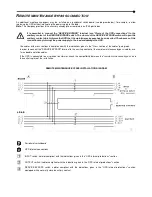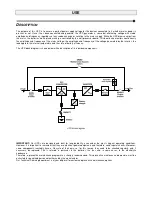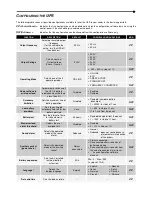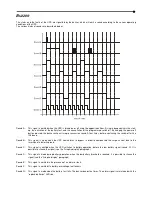
O
PERATING MODE
The mode that guarantees the maximum protection for the load is the ON LINE mode, in which the Energy for the load
undergoes a double conversion and is reconstructed at the output in a perfectly sinusoidal manner, with the frequency and the
voltage set by a precise digital control of the DSP regardless of the input (V.F.I.).
*
In addition to the traditional ON LINE double-conversion mode, it is possible to select the following modes:
ECO (LINE INTERACTIVE)
SMART (SMART ACTIVE)
STBYOFF (STAND-BY OFF)
In order to optimise the efficiency, in ECO mode the load is normally powered from the bypass (any interference on the mains
can affect the load). In absence of the mains, or when the mains voltage exceeds its tolerance limit, the UPS commutates to the
normal ON LINE double-conversion mode. About five minutes after having returned within its tolerance limits, the load is
commutated back to bypass.
If the user cannot decide which is the most suitable operating mode (between ON LINE and ECO) the choice can be left to the
SMART ACTIVE mode, in which, according to statistical data on the quality of the mains power supply, the UPS autonomously
decides in which mode to configure itself.
Finally, in STAND-BY OFF mode, the UPS is set to operate as a back-up device:
In presence of the mains power, the load is not powered, whilst in the event of a black-out, the load is powered by the inverter
via the batteries. When the mains power is restored, the load is powered off again. The activation time is less than 0.5 seconds.
M
AINTENANCE BYPASS
(SWMB)
WARNING: Maintenance inside the UPS must be carried out by qualified personnel trained by the
manufacturer only. In fact, inside the equipment there may be a voltage even when the input, output and
battery switches are open. Removal of the UPS panels by non-qualified personnel may cause harm to the
operator and damage to the equipment.
Listed below are the operations to be performed in order to carry out the maintenance on the equipment with no interruption of
the power supply to the load:
With the mains voltage present, the UPS must power the load through the inverter or the automatic bypass.
N.B.: If the UPS is in battery power mode, activating the maintenance bypass may imply an interruption of the power
supply to the load.
Close the maintenance bypass isolator (SWMB) located behind the door. This way, the input is short-circuited with the
output.
Open the input switches (SWIN), the output switches (SWOUT), and the battery fuse holders (SWBATT) located
behind the door. The signal panel is turned off. Wait for the electrolytic condensers on the power board to discharge
(about 20 minutes) and then proceed with the maintenance operations.
N.B.:
During this phase, with the load powered via the maintenance bypass, any disturbance on the UPS power supply
line would affect the equipment powered (the load is connected directly to the mains. The UPS is no longer active).
Moreover, the auxiliary
"Power share"
and
"Power out" sockets
, are no longer powered (see "
Auxiliary (power
share)sockets"
in the
"USE" section
).
Once these maintenance operations have been completed, perform the following operations to restart the UPS:
Close the input and output isolators and the battery fuse holders. The signal panel is reactivated. Turn the UPS on
again from the “SYSTEM ON” menu. Wait for the sequence to be completed.
Open the maintenance bypass: The UPS resumes normal operation.
*
The rms value of the output voltage is set by the precise control of the DSP, regardless of the input voltage, while the output voltage
frequency is synchronised (within a tolerance range which can be set by the user) with the input voltage, in order to allow use of the bypass.
Outside this tolerance range, the UPS desynchronises adopting the nominal frequency and the bypass can no longer be used (free running
mode).
















































